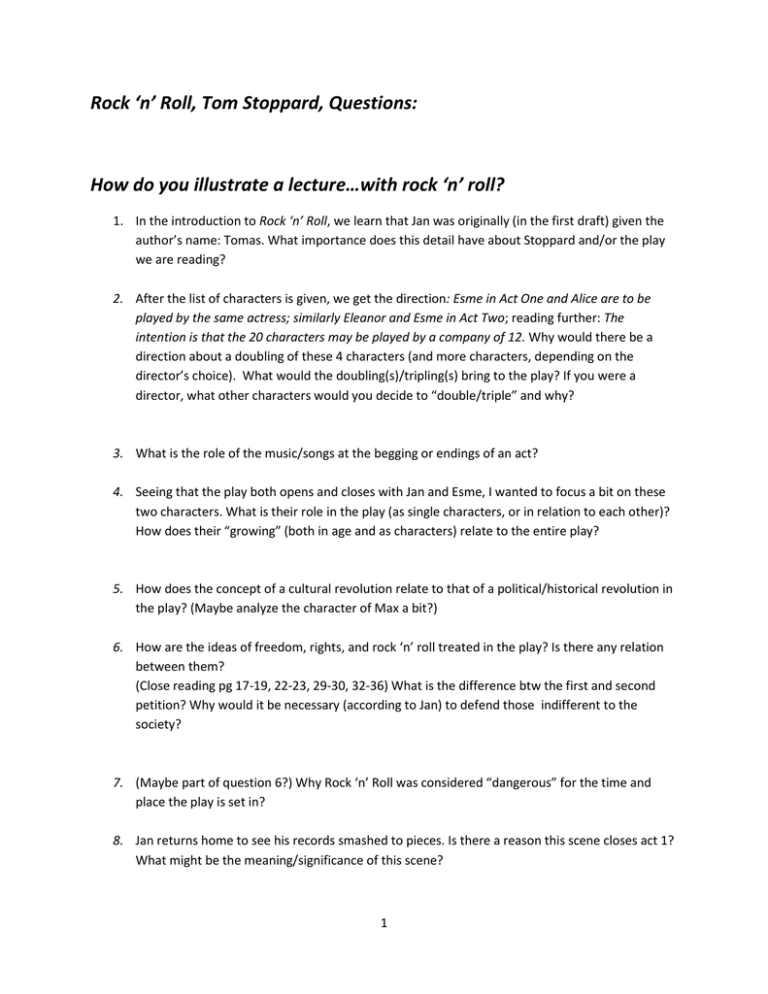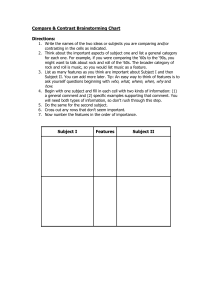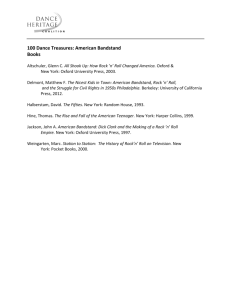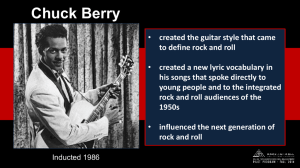Rock ‘n’ Roll, Tom Stoppard, Questions:
advertisement

Rock ‘n’ Roll, Tom Stoppard, Questions: How do you illustrate a lecture…with rock ‘n’ roll? 1. In the introduction to Rock ‘n’ Roll, we learn that Jan was originally (in the first draft) given the author’s name: Tomas. What importance does this detail have about Stoppard and/or the play we are reading? 2. After the list of characters is given, we get the direction: Esme in Act One and Alice are to be played by the same actress; similarly Eleanor and Esme in Act Two; reading further: The intention is that the 20 characters may be played by a company of 12. Why would there be a direction about a doubling of these 4 characters (and more characters, depending on the director’s choice). What would the doubling(s)/tripling(s) bring to the play? If you were a director, what other characters would you decide to “double/triple” and why? 3. What is the role of the music/songs at the begging or endings of an act? 4. Seeing that the play both opens and closes with Jan and Esme, I wanted to focus a bit on these two characters. What is their role in the play (as single characters, or in relation to each other)? How does their “growing” (both in age and as characters) relate to the entire play? 5. How does the concept of a cultural revolution relate to that of a political/historical revolution in the play? (Maybe analyze the character of Max a bit?) 6. How are the ideas of freedom, rights, and rock ‘n’ roll treated in the play? Is there any relation between them? (Close reading pg 17-19, 22-23, 29-30, 32-36) What is the difference btw the first and second petition? Why would it be necessary (according to Jan) to defend those indifferent to the society? 7. (Maybe part of question 6?) Why Rock ‘n’ Roll was considered “dangerous” for the time and place the play is set in? 8. Jan returns home to see his records smashed to pieces. Is there a reason this scene closes act 1? What might be the meaning/significance of this scene? 1 9. Pg 69: John Lennon Wall. Can we make a parallel to The Berlin Wall? 10. Can we see Max, Ferdinand and Jan as representing 3 different intellectual views present at the time in Czechoslovakia? 11. Can we see more than a friendly meeting of most of the characters toward the end of act 2? 12. Close reading 93-95: What does the last confrontation between Jan and Max add to the play, and our reading? 13. The play is titled Rock ‘n’ Roll, but it is neither a history of rock ‘n’ roll, neither is it entirely about rock ‘n’ roll. What were your expectations about the play before reading it , and how do they compare to what you got after reading the play? What would you say Rock ‘n’ Roll is really about? Hey, Ferdo, it’s only rock ‘n’ roll. 2 MIT OpenCourseWare http://ocw.mit.edu 21L.703 Studies in Drama: Stoppard and Company Spring 2014 For information about citing these materials or our Terms of Use, visit: http://ocw.mit.edu/terms.




